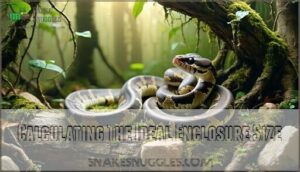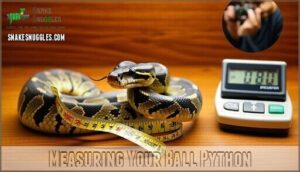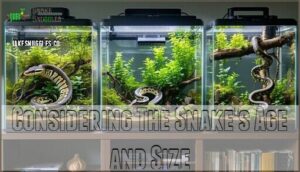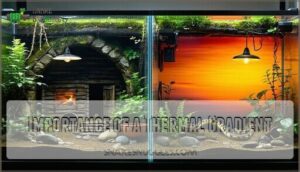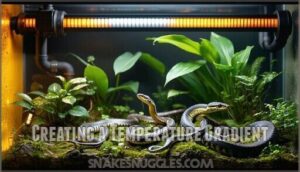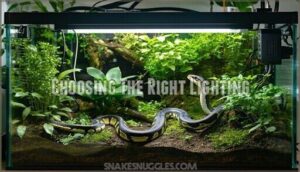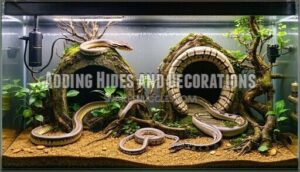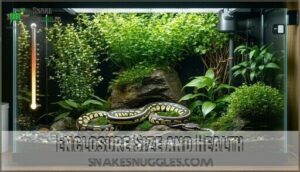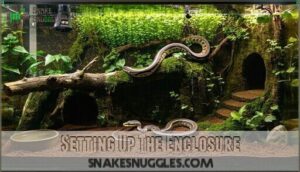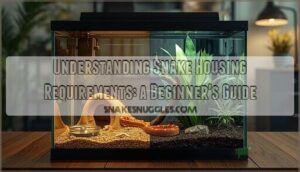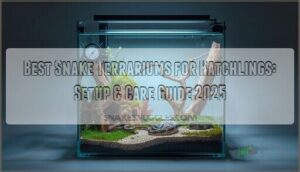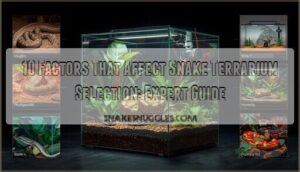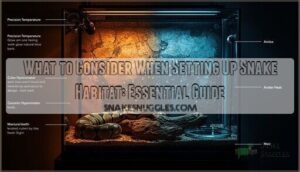This site is supported by our readers. We may earn a commission, at no cost to you, if you purchase through links.
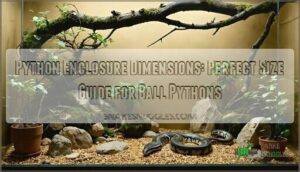
Adults require minimum 4x2x2 feet (length x width x height), though bigger is better. Hatchlings can start in 20-gallon tanks, but you’ll upgrade as they grow.
The old "snake length equals tank perimeter" rule creates cramped conditions. Think of it this way: your python should stretch out completely without touching both ends.
Adequate floor space lets them establish temperature gradients, explore, and exhibit natural behaviors. Size directly impacts their physical and mental health, stress levels, and overall quality of life.
The right dimensions transform a basic setup into a proper habitat that supports everything from proper digestion to confident exploration behaviors.
Table Of Contents
- Key Takeaways
- Ball Python Enclosure Size
- Enclosure Dimensions Explained
- Planning Enclosure Layout
- Enclosure Size and Health
- Setting Up The Enclosure
- Frequently Asked Questions (FAQs)
- How big should an enclosure be for a python?
- Is a 40 gallon terrarium good for a ball python?
- How big should a ball python enclosure be?
- Who makes a Python enclosure?
- Which ball python enclosure is right for You?
- Do ball pythons need enclosures?
- How big should a python enclosure be?
- How big should a carpet python enclosure be?
- Can a ball python live in a 20 gallon tank?
- Is a 75 gallon tank good for a ball python?
- Conclusion
Key Takeaways
- You’ll need a minimum of 4x2x2 feet for adult ball pythons – anything smaller creates cramped conditions that stress your snake and prevent natural behaviors like stretching and exploring.
- Start small with hatchlings, then upgrade as they grow – use 20-gallon tanks for babies under 6 months, then move to 40+ gallons for juveniles, planning ahead for adult sizing.
- Floor space matters more than height – your python needs room to stretch completely without touching both ends, plus adequate space for temperature gradients and enrichment.
- Proper sizing directly impacts your snake’s health – undersized enclosures cause respiratory issues, shedding problems, feeding difficulties, and chronic stress that compromises their immune system.
Ball Python Enclosure Size
You’ll need to determine the right enclosure size based on your ball python’s current length and expected adult size.
Proper sizing guarantees your snake stays healthy and exhibits natural behaviors throughout its life.
Minimum Cage Length and Height
When choosing python enclosure size, length trumps everything else.
Your ball python needs room to stretch completely without coiling.
Professional reptile keepers follow strict python cage requirements that prioritize floor space over enclosure volume.
- Length Rule: Minimum 2/3 of your snake’s total body length
- Height Matters: 12-18 inches allows natural movement patterns
- Floor Space: Adult minimum of 36" x 18" base dimensions
- Species Variation: Larger females need more python habitat dimensions
- Enrichment Needs: Extra space accommodates hides and climbing branches
Ideal Enclosure Size for Hatchlings
Your hatchling needs a first enclosure measuring 20x10x12 inches, providing roughly 200 square inches of floor space.
This python enclosure size prevents stress while accommodating essential hiding spots and water access. Commercial rack systems work perfectly, offering security through opaque walls.
Include two hides and maintain proper feeding frequency schedules. Smaller spaces actually benefit hatchling growth by reducing anxiety and encouraging natural coiling behaviors in their python habitat dimensions.
You can use a python enclosure size calculator to determine the best fit as they grow.
Ideal Enclosure Size for Juveniles
Most juvenile ball pythons thrive in enclosures measuring 30-36 inches long by 12-18 inches wide.
Your snake enclosure calculator should factor in juvenile growth patterns—they’ll need upgrades every 6-8 months.
A 20-40 gallon reptile tank size works well, but avoid oversized python vivarium setups that stress young snakes.
Focus on proper heating setup and enrichment needs rather than excessive space requirements.
Monitor behavior to guarantee your ball python enclosure promotes healthy development.
Ideal Enclosure Size for Adults
For full-grown ball pythons reaching 3-5 feet, your ball python enclosure needs at least 4x2x2 feet dimensions.
This snake tank size provides essential space vs. activity balance while meeting enrichment requirements.
Adult size needs include proper python vivarium size for natural behaviors.
Poor long-term planning and overcrowding consequences include obesity and stress.
Use a snake enclosure calculator for precise reptile tank dimensions.
It’s also important to take into account substrate options for a healthy habitat.
Enclosure Dimensions Explained
You’ll need precise measurements to create the perfect home for your ball python, and getting these calculations right guarantees your snake stays healthy and comfortable.
Understanding how to properly size an enclosure involves measuring your snake’s length, factoring in its current age, and planning for future growth.
Calculating The Ideal Enclosure Size
Three key formulas help determine ideal python vivarium size for your snake’s comfort and health. The length-plus-width rule guarantees adequate space, while species variation and growth rate calculations prevent frequent upgrades.
As they mature, it’s important to reflect on adult tank size for ball pythons.
- Basic Formula: Enclosure length + width should equal your snake’s total length
- Growth Rate Factor: Add 20-30% extra space for juvenile pythons expecting rapid growth
- Activity Level Adjustment: Active species like reticulated python enclosure designs need 25% more floor space
- Enrichment Needs: Calculate additional reptile enclosure volume for branches, hides, and climbing structures
- Future Growth Planning: Size snake tank dimensions for adult length, not current size
Measuring Your Ball Python
To determine proper enclosure requirements, you’ll need accurate measurements of your ball python.
Use a flexible measuring tape to record length from nose to tail tip monthly. Track weight with a digital scale, noting changes during shedding cycles. Document body condition through photos, monitoring growth rate patterns.
These measurements guide snake tank dimensions and reptile enclosure volume calculations for ideal python enclosure setup.
| Measurement Type | Frequency | Purpose |
|---|---|---|
| Length Accuracy | Monthly | Determines minimum enclosure length requirements |
| Weight Tracking | Bi-weekly | Monitors health and growth progression |
| Shedding Measurements | Each shed cycle | Tracks growth spurts and body changes |
| Body Condition | Weekly visual | Assesses overall health and space needs |
| Growth Rate | Quarterly review | Plans future snake habitat size upgrades |
Considering The Snake’s Age and Size
Age and size work together like puzzle pieces when choosing your ball python’s home.
Hatchling enclosure needs start small – a 20-gallon tank works perfectly for babies under six months.
As your snake grows, juvenile space requirements expand to 40 gallons, while adult size impact demands 75+ gallons.
Growth considerations mean planning ahead saves money and stress later.
Planning Enclosure Layout
Planning your enclosure layout requires careful consideration of multiple elements working together to create a healthy environment for your ball python.
You’ll need to establish proper temperature zones, lighting systems, and hiding spots that encourage natural behaviors while maintaining the thermal gradient essential for your snake’s well-being, which includes creating a suitable environment with thermal gradient.
Importance of a Thermal Gradient
Your ball python’s thermal gradient isn’t just comfort—it’s survival.
Temperature zones aren’t luxury—they’re life or death for your python.
Temperature regulation drives their metabolism, digestion, and immune function. Without proper gradient monitoring, you’ll see health impacts ranging from poor appetite to respiratory infections.
A vital element is using a reliable heat source for consistent temperatures.
- Basking Spot: Creates essential warm zone for digestion
- Cool Zone: Provides retreat area for temperature control
- Health Impacts: Poor gradients cause stress and illness
Creating a Temperature Gradient
Position your heating elements at one end to establish a temperature range from 78°F on the cool side to 88-92°F at the basking spot.
Use thermostat control to maintain consistent temperatures throughout your python enclosure design. Accurate temperature regulation devices are vital for reptile wellbeing.
Regular gradient measurement helps your snake thermoregulate effectively, meeting species needs for ideal health and natural behavior patterns.
Choosing The Right Lighting
Since proper lighting transforms your ball python’s world from a sterile box into a thriving habitat, you’ll need UVB lighting paired with heat lamps to create natural light cycles.
Install T5 HO linear fluorescent UVB bulbs overhead for calcium absorption and mental stimulation. You can find the right UVB bulbs online.
Follow lighting safety protocols with protective cages and timers. This python enclosure guide guarantees your reptile vivarium size supports healthy circadian rhythms without disrupting nighttime rest.
Adding Hides and Decorations
Selecting appropriate hides and decorations transforms your reptile tank calculator measurements into a thriving habitat. Place one hide on each temperature zone—warm and cool sides—ensuring your python feels secure throughout its enclosure.
Choose hides sized just larger than your coiled snake. Add climbing branches for juvenile pythons who enjoy vertical exploration.
Position water bowls away from heating elements to prevent excessive evaporation. Substrate choice affects hide placement; avoid materials that retain moisture near warm hides.
Enrichment variety includes artificial plants and textured surfaces that encourage natural behaviors without compromising your snake cage dimensions or python enclosure guide specifications.
Enclosure Size and Health
Your ball python’s enclosure size directly impacts its physical and mental well-being in ways that aren’t immediately obvious.
When you provide adequate space, you’re creating an environment where your snake can regulate its body temperature properly, exercise naturally, and express instinctive behaviors that keep stress hormones in check, which is crucial for maintaining its overall well-being.
How Enclosure Size Affects The Snake’s Health
Your snake’s health directly depends on proper enclosure sizing, with inadequate space creating a cascade of physical problems.
Cramped conditions compromise multiple body systems, leading to measurable health declines that reptile tank calculator tools can help prevent.
- Respiratory Issues develop from poor air circulation in undersized spaces
- Shedding Problems occur when snakes lack room for natural skin removal behaviors
- Activity Levels drop substantially, causing obesity and muscle weakness
- Feeding Habits deteriorate as stressed snakes refuse food more frequently
Proper snake cage dimensions guarantee your python maintains healthy health through natural movement patterns and environmental gradients.
Preventing Stress and Anxiety
Inadequate enclosure dimensions create chronic stress that compromises your ball python’s immune system and overall health.
When cramped, pythons can’t thermoregulate properly or escape perceived threats.
Secure hides positioned at both temperature zones help reduce anxiety. Avoiding overhandling and reducing noise levels near the habitat further minimize stress triggers.
Proper reptile enclosure dimensions calculated through a snake habitat calculator guarantee your python feels secure and exhibits normal behaviors.
To further promote relaxation, consider incorporating air-purifying plants within the enclosure.
Encouraging Natural Behavior
Providing adequate python tank size fosters your snake’s natural instincts and behaviors.
Proper reptile enclosure dimensions using a snake habitat calculator facilitate your Python displaying authentic wild behaviors through strategic enrichment strategies.
- Climbing opportunities with branches encourage vertical exploration and exercise
- Substrate choice enabling burrowing satisfies natural digging instincts
- Foraging behavior stimulation through hiding food promotes hunting skills
Sensory stimulation from varied textures and scents transforms basic snake habitat into dynamic environments that reduce stress while encouraging species-appropriate activities.
Setting Up The Enclosure
Once you’ve determined the proper dimensions and gathered all necessary equipment, you’ll need to set up your ball python’s enclosure completely before bringing your new pet home.
This preparation phase guarantees your snake can settle into a stress-free environment that meets all its biological needs from day one, ensuring a comfortable start with a proper setup.
Preparing The Enclosure Before Bringing The Snake Home
Before your ball python arrives, you’ll need to establish quarantine protocols for at least 30 days in a separate room. Your initial setup requires careful substrate selection—cypress mulch or paper towels work best for monitoring health.
Position your water source on the cool side. Proper ventilation is also essential to prevent mold growth.
| Setup Component | Specification | Purpose |
|---|---|---|
| Python tank size | 40+ gallons for adults | Adequate space for movement |
| Hiding spots | Two identical hides | Security on both temperature zones |
| Temperature zones | 78-80°F cool, 88-92°F warm | Proper thermoregulation |
Like organizing data structures in algorithm implementation, every element must serve a specific function. Your python’s environment mirrors file reading chunk size principles—each component processes information efficiently for ideal health outcomes. This setup is crucial for creating an environment that supports the well-being of your ball python, ensuring it has the necessary conditions for a healthy life with proper temperature zones and security.
Introducing The Snake to Its New Environment
Once your enclosure’s ready, acclimation period begins immediately.
Place your python inside gently, then avoid initial handling for 7-10 days.
This quarantine protocols phase lets your snake adjust to new variables like temperature and humidity.
Watch for stress signs: excessive hiding, refusal to eat, or defensive posturing.
Don’t establish feeding schedule until acclimation ends.
Your python’s object model requires time processing this environmental data types shift.
Respect their memory formation process during this critical adjustment window, allowing them to adjust to the new environment without excessive stress, and ensuring a smooth transition into their new environmental data.
Monitoring The Snake’s Health and Well-being
After settling your python into its new home, you’ll become its health detective.
Watch for changes in eating patterns, shedding cycles, and activity levels that signal potential issues.
Regular Health Checks help identify problems early, while proper Snake Nutrition supports immune function.
Monitor Habitat Quality weekly, checking temperatures and humidity levels.
Effective Stress Management includes maintaining consistent routines and minimizing disturbances.
When concerns arise, prompt Veterinary Care guarantees your python’s wellbeing.
Frequently Asked Questions (FAQs)
How big should an enclosure be for a python?
Your python’s enclosure should provide adequate floor space based on species and size.
Adult ball pythons need minimum 40-gallon tanks, while larger species require proportionally bigger spaces for proper movement and thermoregulation.
Is a 40 gallon terrarium good for a ball python?
Good things come in small packages, but a 40-gallon terrarium won’t cut it for your ball python’s long-term happiness.
You’ll need at least 75-120 gallons for an adult, ensuring proper temperature gradients and adequate space for natural behaviors.
How big should a ball python enclosure be?
Adult ball pythons need enclosures measuring at least 4 feet long by 2 feet wide. You’ll want 75+ gallons total volume for proper space and enrichment opportunities.
Who makes a Python enclosure?
Coincidentally, you’ll discover several reputable companies craft quality reptile habitats. Toad Ranch and Reptile Kages lead American manufacturers, while Vision Products and Zen Habitats specialize specifically in ball python enclosures.
Which ball python enclosure is right for You?
Your ideal ball python enclosure depends on your snake’s size, age, and activity level.
Juveniles need 40-gallon tanks minimum, while adults require 75+ gallons with proper heating, hiding spots, and secure ventilation.
Do ball pythons need enclosures?
Over 95% of captive ball pythons develop health issues without proper enclosures.
Yes, you absolutely need secure, appropriately-sized enclosures for ball pythons.
These escape artists require controlled environments with proper heating, humidity, and ventilation to thrive in captivity.
How big should a python enclosure be?
Your python needs an enclosure that’s at least 40 gallons for adults, with floor space matching their length.
Ball pythons require 4×2 feet minimum, while larger species need proportionally bigger spaces for proper movement and thermoregulation.
How big should a carpet python enclosure be?
Carpets reaching 6-8 feet need minimum 90 x 60 x 120cm enclosures, though you’ll want more length for comfortable movement and health.
Can a ball python live in a 20 gallon tank?
No, you shouldn’t house an adult ball python in a 20-gallon tank. Adult ball pythons need at least 40 gallons, with 75+ gallons being ideal for proper movement and thermoregulation.
Is a 75 gallon tank good for a ball python?
Like upgrading from a studio apartment to a spacious home, you’ll find a 75-gallon tank provides excellent room for your adult ball python to thrive comfortably and explore.
Conclusion
Proper python enclosure dimensions aren’t just numbers on paper—they’re the foundation of your snake’s wellbeing.
You’ve learned that adult ball pythons need minimum 4x2x2 feet, with room to grow as your pet matures.
Remember, bigger enclosures reduce stress, promote natural behaviors, and create healthier snakes.
Don’t shortchange your python with cramped quarters.
Invest in adequate space now, and you’ll enjoy watching your snake thrive for decades to come.
- https://reptifiles.com/ball-python-care-guide/ball-python-terrarium-size-lighting/
- https://community.morphmarket.com/t/reticulated-python-minimum-enclosure-size/20643
- https://www.wilbanksreptiles.com/blogs/ideal-tank-size-for-healthy-ball-pythons/what-is-the-recommended-tank-size-for-a-ball-python
- https://www.reddit.com/r/ballpython/comments/14fm21r/enclosure_size_trying_to_learn/
- https://www.visionproducts.us/solutions/ball-python-enclosures/

